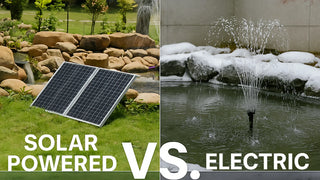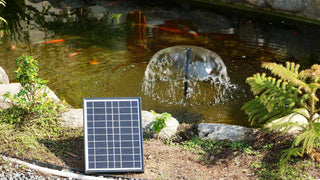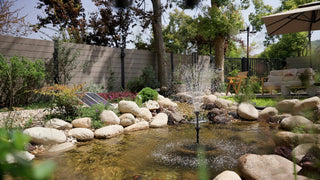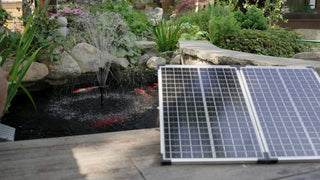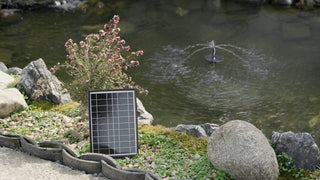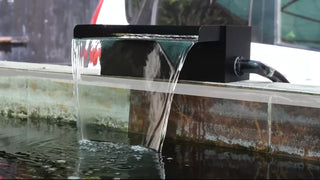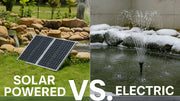
All ponds require circulation. If they don't have it, their water becomes stagnant, algae blooms, and fish experience oxygen deprivation. That's where pumps enter the picture. They circulate water, supply filters, and infuse fountains and waterfalls with life. But for most pond owners, the decision isn't whether to have a pump installed—it's deciding between solar and electric options.
Solar pond pump vs. electric is a concern as the world continues to advance technologically and more individuals are going green. Solar pumps are attractive because they are green friendly and cheap to run, while electric pumps are reliable and better performing. This article breaks down the advantages and disadvantages to help you decide on which is suitable for your pond.
Overview of Solar and Electric Pumps
Solar Pumps

Solar pumps utilize photovoltaic panels to generate energy from sunlight. They are in the form of two primary types: direct-drive (which only operate during sunlight) and battery-backup (which save surplus energy for rainy days or nighttime use). Poposoap's solar pumps are both types, intended to strike a balance between sustainability and functional performance.
Electric Pumps

Electric pumps are powered by an ongoing connection to the power grid. They run 24/7 rain or shine, and as a result are the traditional choice for big ponds or setups that require heavy continuous pressure.
We can see from this pond pump comparison highlighting an obvious trade-off: solar pumps are sustainability and low cost of operation, while electric pumps are dependable and brute force.
Cost Comparison
When comparing startup and long-run costs, prices are significantly different.
Solar Pumps:
Typically lower startup cost because they do not require trenching or electricity cabling. They operate for free after being installed on sunlight. Battery-backup units are more costly to purchase up-front but save on energy bills down the road. Poposoap is concerned with affordability and recyclability in its solar product line for low cost of ownership.
Electric Pumps:
Typically cheaper to purchase initially, especially the small ones. Installation, however, typically requires professional wiring, and one's electricity bill each month adds up. In five or a decade, the cost of operating an electric pump is more than the original price a few times over.
In short, if you’re looking for an eco-friendly pond pump with minimal ongoing costs, solar is the winner. If consistent performance is more important than operating costs, electric may be the better choice.
Performance in Different Climates
Climate plays a major role in the solar pond pump vs. electric decision.
Sunny Locations:
Solar pumps perform best in sunny locations. Direct drives can run properly during the day, and battery types can be used during the evening. Poposoap's solar pumps are specially designed for full-sun light, so they will perform the best in such locations.
Cloudy or Northern Climates:
Electric pumps are a plus in that they can be utilized where sunlight is not assured. Solar pumps fail on several consecutive cloudy days, unless augmented by big panels or batteries. On ponds supporting fish all year, electric pumps provide confidence during darker, colder months.
Seasonal Application:
Summer-only ponds and decorative fountains are perfect for solar pumps. They perform best during the seasons when outside use is highest, without leaving you bound in year-round electricity costs.

This discussion of pond pumps shows how location could be the deciding factor: solar is beautiful in warm climates, and electric for dependability where weather is less predictable.
Maintenance and Longevity
Both pumps require maintenance, but the process differs.
Solar Pumps:
Normal maintenance includes washing solar panels and cleaning pump filters. Panels occasionally must be reset for maximum sunlight exposure, and batteries will eventually wear out. Poposoap's manual recommends routine sponge and impeller cleaning to yield consistent flow. Solar pumps will last for years with proper maintenance.
Electric Pumps:
Require frequent filter cleaning and debris removal like solar pumps. Because they run constantly, they consume faster. They're also more subject to scaling if your pond water is hard. Excellent durability, but electricity costs tend to increase the cost of long-term ownership.
Poposoap's filter boxes make cleaning easy—just rinse and replace reusable pads. With the integration of solar pumps and robust filter systems, maintenance is minimal and eco-friendly.
Environmental Impact and Recommendations

Environmentally, the obvious green pond pump choice is solar. Renewable energy-based, solar pumps eliminate greenhouse emissions and dependency on the grid. They're perfect for gardeners who want to be green and reduce environmental profiles.
Electric pumps, though dependable, consume continuous power and add to the longer-term expense on the environment. But for sensitive fish stock ponds or rely on year-round circulation, electric might be the superior option.
Poposoap's brand identity emphasizes the balance of nature and design, with its products designed to promote healthy water ecologies without excessive utilization of resources. This principle is found in its solar pumps and fountains, making them great choices for homes that seek functionality combined with sustainability.
Final Thoughts
Solar pond pump vs. electric is not a one-size-fits-all situation—just the best choice for your garden and your lifestyle.
Choose solar if:
You enjoy sunny weather, want to save money, and prefer eco-friendly solutions.
Choose electric if:
You require constant, heavy-duty circulation regardless of weather.
For most, a mix is best:
Using solar pumps for fountains and ornaments and an electric pump for cleaning deep down or winter run.
Poposoap’s range of pumps and filter systems makes this flexibility easy. Whether you’re setting up a small decorative water feature or maintaining a large pond, their designs combine durability, simplicity, and sustainability.
With the right choice, your pump won’t just move water—it will bring life, clarity, and balance to your natural pond ecosystem.


